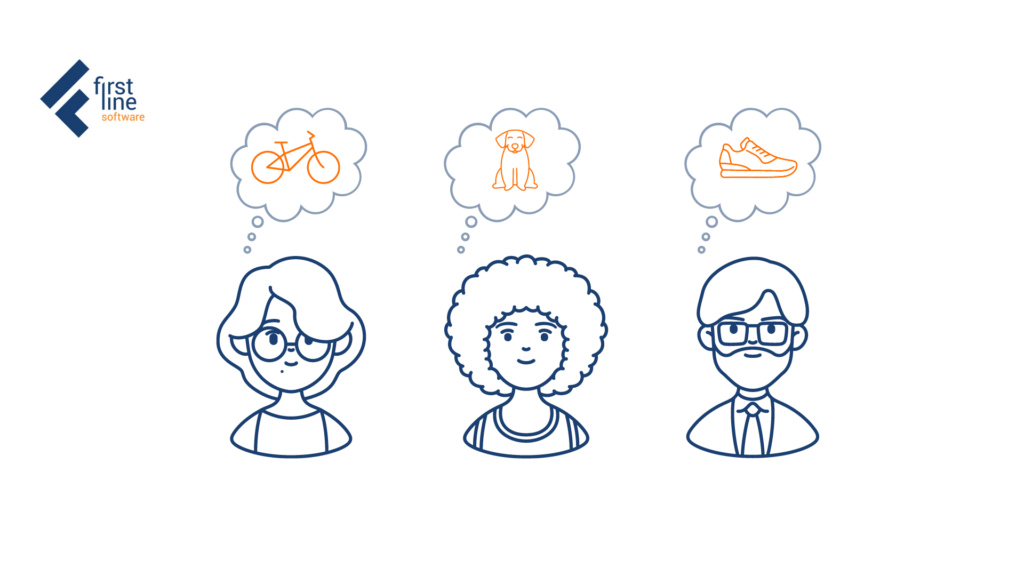First Line Software is a premier provider of software engineering, software enablement, and digital transformation services. Headquartered in Cambridge, Massachusetts, the global staff of 450 technical experts serve clients across North America, Europe, Asia, and Australia.
Today, most digital experience experts say that a seamless and personalized customer experience (CX) is a must. There is a lot of research on how personalization boosts conversions exponentially. And, according to surveys, modern shoppers won’t stay with businesses that don’t offer a CX tailored to their specific needs. But there’s another perspective to consider when it comes to personalization. Here and there, we hear people talk about how machines are watching us, eavesdropping on what we say, and analyzing what we write. This can create a sense of intrusion into privacy and raises many questions. In this blog post, we’ll discuss how to balance personalization without intrusion and use data to bring value, not fear.
What is Omnichannel Personalization?
Omnichannel personalization is the practice of providing customers with a personalized experience across multiple channels such as email, social media, website, mobile app, and in-store. The goal of omnichannel personalization is to provide a seamless and consistent experience, no matter how customers interact with the business.
Omnichannel personalization works by using data and analytics to understand customer behavior and preferences and using that information to deliver tailored content, recommendations, and suggestions across multiple touchpoints.
For example, a website visitor who has abandoned a shopping cart may receive a personalized email offering a discount, while another shopper who makes frequent in-store purchases may receive personalized recommendations through a mobile app.

When does personalization go too far?
What we can call overly personalized communication is an ambiguous question. It is unlikely that we can give a clear answer as to where that dividing point is and when your efforts begin to deprive users of comfort. This will largely depend on the specifics of your business and audience.
However, there is always one outstanding question:
At what point do my users stop expecting their behavior to be monitored?
There are a number of practices that we are all used to. If you search for some product or visit a particular website, it’s likely that you’ll see their ads later. When we leave items in the shopping cart, we can expect the store to send a reminder email after some time. This is already familiar and does not cause concern
But there are other cases – if you somehow track behavior in offline stores, or use the collected data on purchases to find out how many boxes of chocolates a customer eats per month, and then decide to play on this data and offer the 101st box at a discount (or exercise mat), maybe you’re going too far.
How do you leverage personalization plays a role
The form in which you use personalization also plays a role. If, based on the data, you’ve found out that everyone who buys these sweets also buys a certain wine, and you offer it to the customer in the recommendations, you are not likely to cause suspicion because the connection is not as obvious.
Or, for example, if you run retargeting ads on the products that the visitor viewed on the website, you’re still providing relevant personalization — at a distance.
But if you send him an email saying: “We noticed that on 04/22 you opened the details of these black boots, but did not put them in the basket,” the personalization might be getting a little too close to home.
Personalization and the level of detail are a fine line—and identifying that fine line with your customers should be a high priority for you. In this case, it’s better to conduct research and collect feedback data from real users in order to make informed decisions about your personalization strategies.

How can you reduce customer anxiety about the use of their data?
There are several approaches that you can use together or separately that will help you create confidence with your customers in how their data is used.
Be Transparent
Be open about what data collection methods and policies you use. Provide information about what data you register, how it is processed and used, and with whom you share it (if you do). Make sure this information is accessible and easy to find and understand.
Ask for Permission
Use consent-based personalization. Ask users if they agree to share data and receive personalized content. This way, you will help customers maintain a sense of control and peace of mind.
Let Users Control Data
You can go further and ask not only for consent but to give your customers the opportunity to choose which data they are willing to share and what they would not like to provide. Make sure users understand what they are choosing by providing explanations.
Limit or Minimize the Data Collection
Inspect the dataset you are collecting. Is it all necessary for your next steps? Limit and minimize the data you collect, save only what is really needed. If you use a minimization approach, you can include this information on your pages and documents related to your data policy.
Handle Data Responsibly
Be careful about your data governance. Who has access to what data? Where do you store it? Can the data be transmitted to someone and in what form? Your data governance must be clearly defined and executed effectively.
Data Anonymization
Data anonymization is another effective strategy that can be used to address privacy issues. Anonymization is the process of removing personally identifiable information (PII) from data. So that it cannot be linked back to the specific person. This is particularly important in highly regulated industries, such as healthcare.
Anonymization can be achieved through various methods such as:
- Masking – the process of replacing identifying information (such as names or email addresses) with generic identifiers ( “User 1” or “User 2”).
- Aggregation is the process of combining data from multiple individuals and presenting it in such a way that it is impossible to identify one individual.
- Encryption – conversion of data into a code that can only be decrypted with a key. Encryption is useful when you need to protect data in transit or storage.
By anonymizing data, you can still gain valuable insights into customer behavior without compromising privacy.
How to ensure effective anonymization?
- Use strong encryption – When encrypting data, use strong encryption algorithms and store keys securely.
- Monitor data usage – Monitor how anonymous data is used to ensure it is not re-identified or misused.
- Limit access to data – Give access to anonymous data only to those who need it and have a legitimate business need to do so.
Leverage Best Practices with High Technological Expertise
Omnichannel personalization, data collection, data protection, and management—all of these processes must be organized with high-class accuracy and attention to detail.
At First Line Software, we work with a wide stack of technologies in various industries. Therefore, within one company, we have expertise in digital experiences and personalization, as well as data management, and cybersecurity.
Whether you’re just beginning your omnichannel personalization journey or you are already using technologies, we can help you put together the right team of experts to balance the responsible use of data while creating personalized experiences for your customers.
Talk to us today to get started with your personalization journey!


 Clinovera
Clinovera



